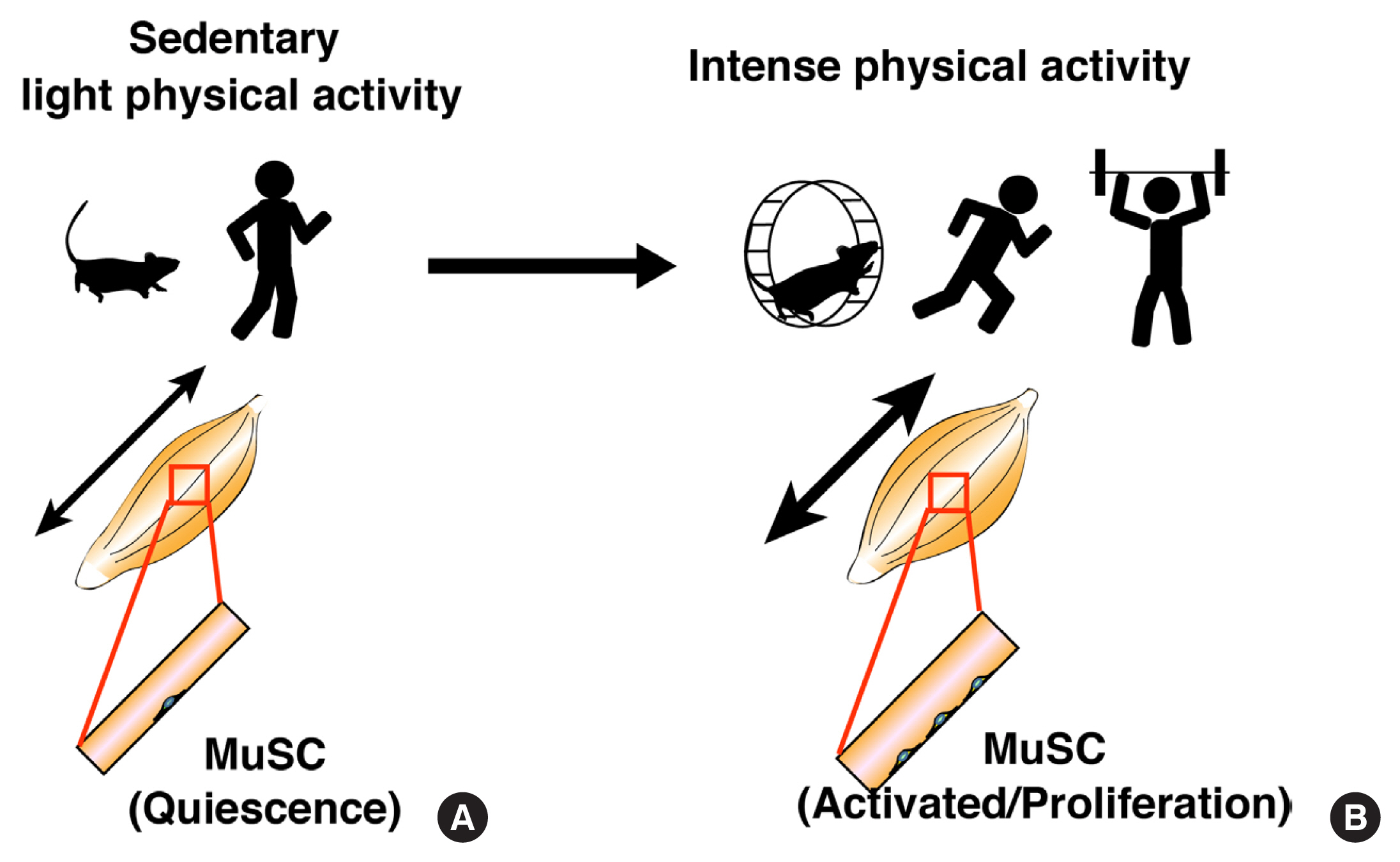Search
- Page Path
- HOME > Search
Review Article
- Diabetes, Obesity and Metabolism
- Exercise/Resistance Training and Muscle Stem Cells
- So-ichiro Fukada, Ayasa Nakamura
- Endocrinol Metab. 2021;36(4):737-744. Published online August 10, 2021
- DOI: https://doi.org/10.3803/EnM.2021.401

- 5,252 View
- 260 Download
- 6 Web of Science
- 7 Crossref
-
 Abstract
Abstract
 PDF
PDF PubReader
PubReader  ePub
ePub - Skeletal muscle has attracted attention as endocrine organ, because exercise-dependent cytokines called myokines/exerkines are released from skeletal muscle and are involved in systemic functions. While, local mechanical loading to skeletal muscle by exercise or resistance training alters myofiber type and size and myonuclear number. Skeletal muscle-resident stem cells, known as muscle satellite cells (MuSCs), are responsible for the increased number of myonuclei. Under steady conditions, MuSCs are maintained in a mitotically quiescent state but exit from that state and start to proliferate in response to high physical activity. Alterations in MuSC behavior occur when myofibers are damaged, but the lethal damage to myofibers does not seem to evoke mechanical loading-dependent MuSC activation and proliferation. Given that MuSCs proliferate without damage, it is unclear how the different behaviors of MuSCs are controlled by different physical activities. Recent studies demonstrated that myonuclear number reflects the size of myofibers; hence, it is crucial to know the properties of MuSCs and the mechanism of myonuclear accretion by MuSCs. In addition, the elucidation of mechanical load-dependent changes in muscle resident cells, including MuSCs, will be necessary for the discovery of new myokines/exerkines and understating skeletal muscle diseases.
-
Citations
Citations to this article as recorded by- Control of muscle satellite cell function by specific exercise‐induced cytokines and their applications in muscle maintenance
Qian Guo, Qing Luo, Guanbin Song
Journal of Cachexia, Sarcopenia and Muscle.2024; 15(2): 466. CrossRef - Resistance exercise preconditioning prevents disuse muscle atrophy by inhibiting apoptosis and protein degradation via SESN2 in C57BL/6J mice
Yating Huang, Chenxin Jiang, Xiuru Li, Sujuan Liu, Yanmei Niu, Li Fu
Biochimica et Biophysica Acta (BBA) - Molecular Basis of Disease.2024; 1870(4): 167111. CrossRef - Anthropometric, muscle and serum myokine levels effects of physical exercise with an online platform in female patients with obesity
David Primo, Olatz Izaola, Juan Jose Lopez Gomez, Daniel de Luis
Endocrinología, Diabetes y Nutrición.2023; 70(7): 484. CrossRef - Anthropometric, muscle and serum myokine levels effects of physical exercise with an online platform in female patients with obesity
David Primo, Olatz Izaola, Juan Jose Lopez Gomez, Daniel de Luis
Endocrinología, Diabetes y Nutrición (English ed.).2023; 70(7): 484. CrossRef - The muscle stem cell niche at a glance
Margaret Hung, Hsiao-Fan Lo, Grace E. L. Jones, Robert S. Krauss
Journal of Cell Science.2023;[Epub] CrossRef - Exercise Therapy for People With Sarcopenic Obesity: Myokines and Adipokines as Effective Actors
Hamed Alizadeh Pahlavani
Frontiers in Endocrinology.2022;[Epub] CrossRef - Molecular mechanisms of exercise contributing to tissue regeneration
Jibao Chen, Ren Zhou, Ye Feng, Lin Cheng
Signal Transduction and Targeted Therapy.2022;[Epub] CrossRef
- Control of muscle satellite cell function by specific exercise‐induced cytokines and their applications in muscle maintenance

Original Article
- Comparison of Target Organ Damages between Primary Aldosteronism and Essential Hypertension.
- Juri Park, Dong Jin Kim, Sae Jeong Yang, Sook Hae Kim, Soo Yeon Park, Hye Jin Yoo, Yun Jeong Lee, Hee Young Kim, Ohk Hyun Ryu, Kye Won Lee, Ji A Seo, Sin Gon Kim, Kyung Mook Choi, Sei Hyun Baik, Dong Seop Choi
- J Korean Endocr Soc. 2007;22(1):11-18. Published online February 1, 2007
- DOI: https://doi.org/10.3803/jkes.2007.22.1.11
- 2,021 View
- 20 Download
- 3 Crossref
-
 Abstract
Abstract
 PDF
PDF - BACKGROUND
A number of recent clinical studies have reported marked target organ damages in patients with primary aldosteronism. The aim of this study was to compare the incidence of target organ damages in patients with primary aldosteronism (PA) and essential hypertension (EHT). METHODS: The clinical records of 41 PA patients, over a 20-year period, were retrospectively analyzed. The clinical characteristics and incidence of target organ damages of 33 of the patients in this group were compared with those of 66 patients with essential hypertension, directly matched for age, gender and mean blood pressure. 8 of the PA patients could not be matched with EHT patients for age, gender and mean blood pressure, so were excluded from the comparison. The patients with essential hypertension were sampled from patients who visited for the evaluation of hypertension. RESULTS: Ischemic heart diseases were found in 18.2 and 10.6% of patients with PA and EHT, respectively (P = 0.22). From echocardiograms, left ventricular hypertrophy was found in 93.3% and 61.4% of patients with PA and EHT, respectively (P = 0.017). The degrees of left ventricular hypertrophy were correlated with the levels of serum aldosterone, with an r value of 0.490 (P < 0.005). Cerebrovascular attack was found in 18.2% and 1.5% of patients with PA and EHT, respectively (P = 0.005). Hypertensive retinopathy was found in 50% and 33.3% of patients with PA and EHT (P = 0.255), and nephropathy was found in 42.4% and 25.8% of patients with PA and EHT, respectively (P = 0.074). CONCLUSION: Patients with primary aldosteronism had target organ damages more frequently than with those with essential hypertension, which was independent of blood pressure. -
Citations
Citations to this article as recorded by- Changes in the clinical manifestations of primary aldosteronism
Sun Hwa Kim, Jae Hee Ahn, Ho Cheol Hong, Hae Yoon Choi, Yoon Jung Kim, Nam Hoon Kim, Hye Jin Yoo, Hee Young Kim, Ji A Seo, Nan Hee Kim, Sin Gon Kim, Kyung Mook Choi, Sei Hyun Baik, Dong Seop Choi
The Korean Journal of Internal Medicine.2014; 29(2): 217. CrossRef - Comparing the Prevalence of Primary Aldosteronism in Hypertensive Diabetic and Non-diabetic Patients
Yi Sun Jang, Koon Soon Kim, Hye Soo Kim
Journal of Korean Endocrine Society.2009; 24(4): 254. CrossRef - Aldosterone as a Cardiovascular Risk Factor
Soon Jib Yoo
Journal of Korean Endocrine Society.2007; 22(1): 8. CrossRef
- Changes in the clinical manifestations of primary aldosteronism


 KES
KES

 First
First Prev
Prev



